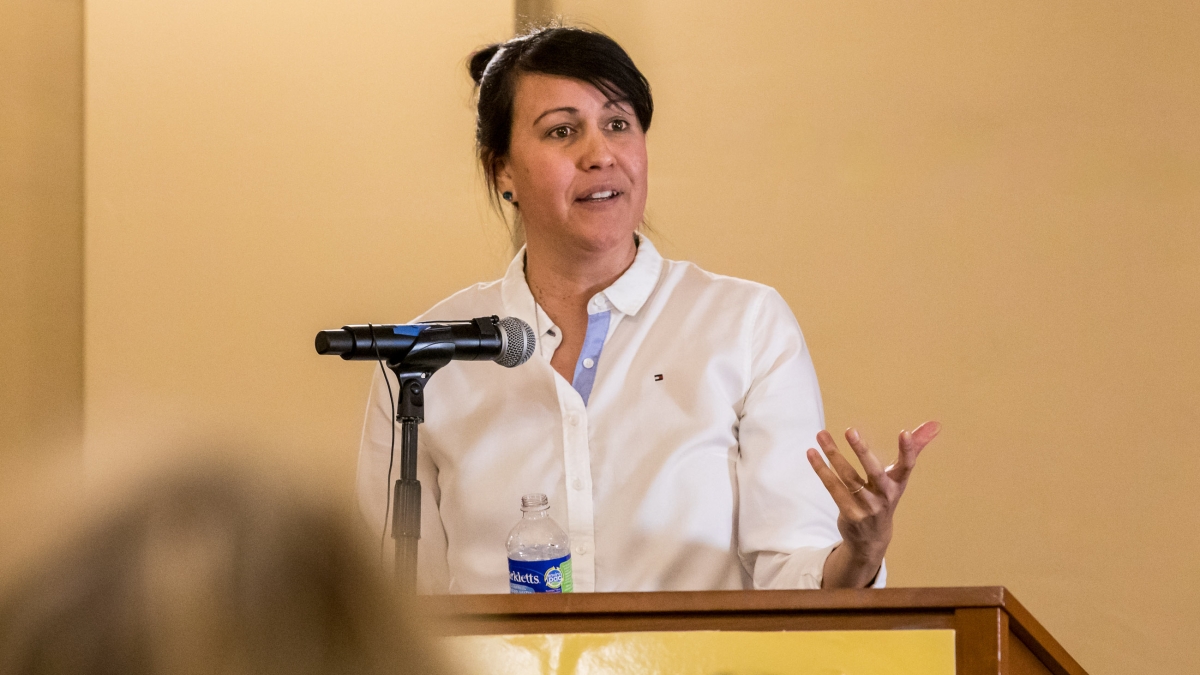ASU and MacArthur ‘genius' poet Natalie Diaz shows the power of language, humanities

ASU poet, professor and 2018 MacArthur fellow Natalie Diaz reads newer works to a group of some 250 students, faculty and community members at Old Main. Photo by Bruce Matsunaga
“What is the language we need to live right now?”
That’s the question Arizona State University poet Natalie Diaz posed to an audience of some 250 students, faculty and community members during a presentation of her works at Old Main on the Tempe campus this week.
Diaz, who is the current Maxine and Jonathan Marshall Chair in Modern and Contemporary Poetry and an associate professor in the Department of English, was one of 25 John D. and Catherine T. MacArthur Foundation “genius grant” fellows in 2018. Drawing on her experiences growing up on the Fort Mojave Indian Village in Needles, California, and navigating indigenous, Latinx and queer identities, her work challenges the belief systems of contemporary American culture.
A collaboration between the College of Liberal Arts and Sciences, the Department of English and the Virginia G. Piper Center for Creative Writing, the event marked her first reading at ASU.
Dean of Humanities Jeffrey Cohen said it celebrated Diaz’s work on its own and its influence on the college.
“When the news came of her ‘genius’ award, we felt like the world was catching up with something we at ASU have always known,” he said. “Natalie has been doing important teaching and work here for several years that has enabled our students to thrive along with her.”
Even without last year’s MacArthur award, that impact is evident. Diaz’s work has amassed far-reaching acclaim over the last decade and since the release of her first collection, "When My Brother Was an Aztec," by Copper Canyon Press in 2012. But in that first question at Old Main, she invited audience members to think beyond the written word.
“Poetry for me, the least of it is what is happening on my page,” she said. “That is only where it begins.”
Language as a three-dimensional force is a concept Diaz has explored a lot. As a former professional basketball player, she has compared writing to the physical force of playing the sport. In addition to her own writing, she has worked with ASU’s Center for Indian Education to preserve the Mojave language by documenting stories and transcribing conversations with elders.
It is within that cross-boundary lens that Diaz encouraged people at the reading to think of poetry. As society continues to shift, she said, language is a tool to redefine the world.
“Our young people learning languages are now charged with creating new words to describe the things in their life,” she said. “That’s why I think poetry is so important — it is concerned with every single word, and that’s why the humanities are also so important.”
Likewise, Cohen said Diaz’s forward-thinking outlook on language helped usher in a new era of learners.
“One of the many things I admire about Professor Diaz is that she is student-centered,” he said. “Much of what she does here is ensuring that the next generation has every opportunity to flourish.”
In order to stay relevant, Cohen said, humanities studies must resonate with students themselves. Scholars like Diaz exemplify the potential.
“Many of our ASU students are first-generation, and often students of color, and sometimes lacking in models for the various kinds of futures they can make,” he said. “When they look at her, many will see what is possible for themselves.”
That was the case for Laramie Kisto, a Chandler-Gilbert Community College student and member of the Gila River Indian Community, to which Diaz also belongs.
“I’m studying social work, and being able to express my past through poetry is an outlet I’m interested in,” said Kisto, who plans to attend ASU after completing courses at Chandler-Gilbert. “Coming here and seeing someone from my community showed me that there could be an entry for me, too.”
Diaz read a handful of newer works that touched on everything from basketball and family crises to police violence against Native Americans and the very physical sensation of moving one’s hips.
Napoleon Marrietta, a graduate student in the College of Liberal Arts and Sciences’ American Indian Studies program, said the breadth of Diaz’s selection spoke to the power of language in activism.
“My thesis is focused on indigenous activism in the Phoenix area and how we implement different voices to fight for a cause,” he said. “I think poetry can shed some light on a lot of the things we deal with at home.”
More Arts, humanities and education

ASU professor's project helps students learn complex topics
One of Arizona State University’s top professors is using her signature research project to improve how college students learn…

Award-winning playwright shares her scriptwriting process with ASU students
Actions speak louder than words. That’s why award-winning playwright Y York is workshopping her latest play, "Becoming…

Exceeding great expectations in downtown Mesa
Anyone visiting downtown Mesa over the past couple of years has a lot to rave about: The bevy of restaurants, unique local shops…

